History of Tluste/Tovste
from a Jewish Perspective
Introduction
The following pages give an overview of the history of Tluste/Tovste
and of the region in which it is situated from the perspective
of the Jewish population, one of three principal ethnic groups
that co-existed there. Polish and Ukrainian perspectives each
receive their own treatment elsewhere in dedicated overviews;
while the section 'Tluste - Life
and Times' attempts to give an overall impression of what
the town was like between 1880 and 1930.
While their histories are necessarily intertwined, a case
can be made for presenting these ethnic perspectives separately.
For, although they lived side-by-side for many centuries,
persistent tensions among these communities ensured that they
maintained distinct identities and separate affiliations throughout
their long co-existence.
Each of these overviews is a work in progress. They will
be supplemented by additional information as it comes to light.
Indeed, there are many rich sources of historical information
already at hand, waiting to be translated into English from
the original Hebrew, Polish or Ukrainian texts. While no claim
is made that the information presented here is comprehensive,
it should nonetheless give a fairly good sense of the social
interactions, over time, among these three communities. 
The Polish Era
From the 14th to 18th centuries, the Polish-Lithuanian Commonwealth
expanded to cover a huge territory in northern Europe. During
this period, Tluste was part of the fertile province of Podilia
(also written as Podole in Polish, Podillia in Ukrainian).
Ruthenian (Ukrainian) peasantry made up the vast majority
of the populous, while Jews settled in newly created towns
and were heavily involved in the administration of large tracts
of land granted to noblemen. These formed the basis for the
latifundia, vast estates characterised by primitive agriculture
and indentured labour. (1).
The existence of a Jewish population in Tluste can be documented
at least as far back as the early part of the eighteenth century,
and probably much earlier. Though few, if any, Jews live in
Tovste today, this belies the fact that from at least the
middle of the nineteenth century until well into the first
few decades of the twentieth century, Tluste was predominantly
a Jewish town.
According to Rosman (2)
, the mid-seventeenth century Jewish community of the Commonwealth
enjoyed a large measure of freedom in economic, religious
and internal communal affairs -- owing to a tradition of Polish
tolerance as well as compelling utilitarian reasons. However,
sporadic anti-Jewish violence fostered an undercurrent of
insecurity. This was manifested most dramatically in the peasant
uprising of 1648, led by the Cossack Bohdan
Khmelnytsky, which had profound effects for Podolia and
its Jewish population. Although initiated as a protest by
Cossacks against their treatment by Polish landlords, it was
transformed into a widespread campaign of violence against
anyone identified with the "establishment", particularly Jews
who lived in urban areas (3).
Some estimates put the number of Jewish victims in the whole
of Ukrainian territory at up to fifty percent of the total
population of 40,000 (4).
Though the situation in Podolia eventually stablised, the
last three decades of the century saw further economic and
social decay, as the territory was ceded to the Ottoman Empire
through the 1672 Treaty of Buczacz. It was not until the end
of the seventeenth century, when Poland recovered Podolia
once again, that prosperity began to return. Magnate latifundia
owners solicited Jews and other townspeople to re-establish
life in towns; and a modified Jewish-dominated leasing system
was revived (5).
Rosman (6)
gives a sense of the Podolian environment into which Tluste's
most famous son, the Ba'al
Shem Tov, was born around 1700 — not in Tluste,
but in the village Okupy, near the southern border with Moldavia:
"Culturally, eighteenth-century Podolia was a crossroads.
Each of the three dominant ethnic groups -- Poles, Jews,
and Ukrainians -- had its own language, religious ritual,
and elite culture." Their everyday life -- marked by different
Sabbaths, holidays and even calendars -- made it impractical
for them even to share a meal or celebration together.
On the other hand, "close proximity, familiarity with each
other's lifestyles, business and other utilitarian considerations
and subtle, shared assumptions about reality and the means
for contending with it, all contributed to a situation in
which Jews and Christians found the opportunities and the
means to communicate with each other."
"Jewish-Christian social encounters can be schematised
as occupying a spectrum ranging from antagonistic encounters
during wars, riots, raids, holdups, and casual street physical
and verbal violence through more or less acrimonious but
controlled confrontations in law courts to mildly negative,
neutral, or friendly business, neighbor, and health (or
spirit) care relationships and culminating in real individual
friendships and group wartime alliance and cooperation."
As it happens, the birth of Rabbi Israel ben Eliezer at the
turn of the century coincided with a period of recolonisation
and revitalisation of Podolia, whereas the Commonwealth as
a whole continued its economic decline. Jews took advantage
of the opportunities afforded by this newfound growth and
prosperity; by 1764, their population in Podolia numbered
some 40,000 -- six percent of the total Jewish population of
the Polish-Lithuanian Commonwealth. "Along with everyone in
the region, the Jews benefited from the moderate degree of
stability afforded by magnate rule and the economic boom that
was the effect of recolonization... In Polodia, Jews and Christians
shared the physical, social, cultural, and economic environment,
even if they did not operate in the same universe of discourse."
| Rabbi Israel ben Eliezer chose to settle
in Tluste, around 1734, and to reveal himself there as
the Ba'al Shem Tov. His connection to Tluste is confirmed
by various sources: two of the rare surviving letters
signed by the Besht indicate that Tluste was his home
or place of origin; there are two references to Tluste
in the tales of his life and deeds, depicted in Shivei
Ha-Besht: In Praise of the Baal Shem Tov (7);
and his mother is buried in Tluste's Jewish cemetery,
where her tombstone could be found until the time of World
War II.) |
|
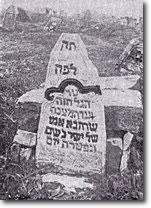 |
One may speculate that there must already have been a modest
Jewish population in Tluste for the young rabbi to have chosen
to settle there. Indeed, a census conducted in 1764, three decades
after the Besht's revelation, indicated that there were then
355 Jewish residents of Tluste and surrounding villages (8).

Under Austrian Rule
In 1772, the vast territory that had been the Polish-Lithuanian
Commonwealth was subjected to the first of three partitions
that would take place before the end of the century. The Austrian
Empire absorbed Polish territory that would become the new
province of "Galicia and Lodomeria", more commonly known as
"Galicia", so-named after the historic Ukrainian appellation
for the region, and its ancient capital of Galicz (Halicz).
Tluste was thus included in this expanded Austrian Empire,
and would remain so until 1918.
The reign of Empress Maria Theresa and her successors through
to Emperor Ferdinand, who abdicated in 1848, was fraught with
difficulties and ineffectual reforms -- partly a consequence
of having to deal with many divergent ethnic interests. Jews
were said to have fared better under the 68-year reign -- from
1848 to 1916 -- of Franz Josef, who reformed the restrictive
and harsh policies of his predecessors and sought Jewish allies
in his efforts to retain control of Galicia.
In the nineteenth century, the Jews of Tluste traded in agricultural
produce, timber, cloth, and beverages. Hasidism was preponderant
in the town. The wealthy members of the community (estate
owners, contractors and merchants of forest products and hides)
were followers of the zaddik of Chortkov (a town
20 km to the north), whereas shopkeepers, grain merchants,
brokers and scholars adhered to Viznitsa Hasidism, and the
artisans were followers of the zaddik of Kopychintsy
(9).
The growing importance of the Jewish population in Galicia,
as a whole, during Austrian rule is reflected in statistics
compiled in the framework of the 1880 census (10).
The percent of Jewish pupils in Gymnasien and Realgymnasien
rose from about 6 percent in 1851 to nearly 20 percent by
1880, with much of that growth occurring in the last six years
of the survey period (i.e. 1874-1880).
The picture for Realschulen was somewhat different,
with Jewish pupils already constituting a relatively high
percentage (i.e. close to 20 percent) of the school population
from the early 1850s. Apart from a 7-8 year lull — from
1868 to 1874 — when this figure dropped to as
low as 10%, the percentage of the overall school population
remained relatively high throughout the 30-year period, and
stood at 23 percent in 1880. In absolute terms, the highest
enrollment was achieved in 1877, when 377 of 1557 Realschulen
students in Galicia were reported to be of Jewish origin.
Between 1880 and 1930, the population
of Tluste grew steadily from 3,285 individuals to a peak
of about 4,000; while that of the town and the suburbs together
grew from 6,000 to just over 8,000. What is most remarkable
about these figures is the clear indication that, during this
period, Tluste was predominantly a Jewish town. Jews consistently
made up approximately two-thirds of the population, while
Ukrainians constituted about 20-30% and Poles only 11-12%.
Contrasting the composition of Tluste proper, the smaller
surrounding villages were made up primarily of Ukrainians
(roughly three-quarters) and Poles (20-25%). Jews constituted
less than five percentage of their population and virtually
all of them were tradesmen, shopkeepers and their families.
This clear tendency for the Jewish community to concentrate
in towns, rather than smaller villages, was common elsewhere
in Galicia. The 1764 census of Polish Jewry, mentioned earlier,
indicates that there were already 251 Jews living in Tluste
alone. At that time, a relative large proportion of the total
Jewish population (about 30%) lived in surrounding villages,
but over the next one hundred years there was an obvious migration
towards Tluste proper.
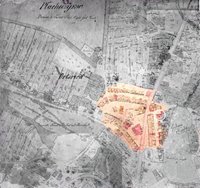 |
|
The prominence that the Jewish community
had attained in Tluste by the mid-nineteenth century
is revealed in the earliest known map of the town, a
precise Austrian document dating from 1858.
The central market area of town -- surrounding the Catholic
church -- was comprised mainly of Jewish-owned shops
and businesses, selling food, fabric and other household
goods. |
| |
|
|
| A synagogue
(centre of photo) stood on the opposite side of the
main road through town, close to the northern end of
the reservoir.
All of these buildings appear again in another Austrian
map prepared in 1899. By that time, the Jewish population
of Tluste had grown to nearly 2,500 residents. |
|
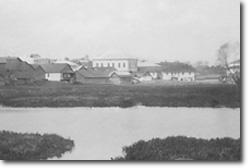 |
The 1891
Galician Business Directory lists the occupations of about
70 individuals engaged in commercial activities in Tluste towards
the end of the nineteenth century
(11). Most of the family names in the list appear to be
of Jewish, Polish or German origin; the list contains few if
any Ukrainian-sounding names. Members of the Jewish community
were involved in all facets of the town's livelihood -- in the
food and service sectors, as dealers of raw materials and hardware,
in retail establishments, and as tradesmen and professionals.
Notwithstanding the relative prosperity that they evidently
enjoyed, Tluste's Jews also took part in the wave of emigration
from Ukraine to America that occurred around the turn of the
century. "Economic distress, epidemics, anti-Semitism and
a desire for a better life led many Jews to emigrate from
Galicia in the last years of the nineteenth and the early
years of the twentieth century" (12).
In New York, in 1898-99, Jewish immigrants from Tluste established
and incorporated a fraternal mutual aid society, known as
a Landsmannshaft. A number of these Landsmannshaften
were created by immigrants from Tluste/Tovste, and at
least one - the Young Tluste Society - continues to operate
today. (One can observe in Wellwood Cemetery, Pinelawn, New
York, a memorial
erected by the Tluste Society in remembrance of families
who perished in Tluste and vicinity.)
With the onset of the First World War, Russian soldiers occupied
Tluste in the second half of 1914. Jews suffered at the hands
of the Russians during the wartime occupation. According to
Pawlyk, local people were frightened and wary of the arrival
of the Russians, and expected them to be cruel -- to murder
Ukrainians, especially Jews, many of whom fled to Vienna.
Local people decided to put icons in the windows so that the
Russians could see that they were not Jewish. The occupiers
forced Jews to work to maintain order and to keep the town
clean but soon, through bribing, the Jews began to co-operate
with them (13).
Apparently the Russians were constantly in search of vodka,
which the Tsar had prohibited at the beginning of the war
.
Tluste and surrounding areas changed hands a number of times
during the war. Some time in the winter of 1914-15, the Austrians
managed to drive out the Russian army. Pawlyk reports that
in the summer of 1915 the front line was further along, on
the Dniester river. There, the Austrian army used bacteriological
weapons, which killed first the soldiers and then people in
villages and towns along the river. Many soldiers sick with
cholera were brought to Tluste hospital, which was located
close to the railway station. Those sick soldiers usually
died within several hours. They were buried in a separate
"cholera cemetery", which was established near the Jewish
quarter. Soon, many local people -- especially Jews -- were
infected, and a sanitary service was organised.
Having been driven out of the area in the autumn of 1915,
the Russians returned in June 1916 and remained in the Tluste
through July 1917. The war ended in 1918 with the downfall
of the Austrian-Hungarian Empire. 
The Inter-war Years
Writing about history of the region and the village of Suchostaw,
located about 35 km north of Tluste, it was noted that by
the aftermath of the First World War, the best days for Galician
Jews were probably behind them (14):
"After the War, the Jews remaining in the region found
themselves in a much changed position. Instead of the considerable
civil rights they had held in the multinational Austro-Hungarian
Empire, they now found themselves a minority in a devastated
area of newly independent Poland. Here political and economic
power resided with the Polish minority who were none too
interested in sharing it with the resident Jewish population.
Neither were the local and dominant population of Ukrainian
peasants any less hostile to Jews. Soon Polish authorities
banned Jews from government posts, boycotted Jewish businesses,
imposed new taxes, and restricted Jewish entry into high
schools and universities. A sense of despair was felt in
shtetlach throughout the region.
The Jewish response was varied: labor organizations were
created, Zionist groups took hold, mutual aid and economic
support associations were created."
In Tluste, the Jewish population maintained
itself, reaching a peak of 2,600 by 1930, the last year
for which complete census data are available.
According to Encyclopedia Judaica (15),
"all the Zionist parties were active in the town and
there was a Tarbut Hebrew school" (pictured at right).

|
|
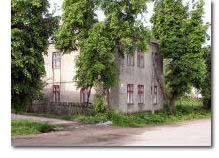 |
Tluste and the Holocaust
When the Second World War broke out in 1939, the Jewish
population of Tluste had already declined to less than 1200,
fewer than half the number of residents recorded at its peak
in 1930. (In his 1996 survey of the Jewish cemetery of Tovste
(16),
Hodorkovskiy Yuriy Isaakovich quotes a figure of 1,196 Jewish
residents of the town in 1939; whereas Encyclopedia Judaica
(1972) attributes this same figure, apparently incorrectly,
to 1921.)
With the fall of Poland in September 1939, Soviet forces
occupied Tluste and neighbouring towns. They remained there
until June 1941, when Nazi Germany commenced hostilities against
the Soviet Union. Tluste was captured by the Hungarian army,
which was an ally of Germany. Groups of Jewish youth attempted
to escape to the USSR with the retreating Soviet army, but
only a few succeeded (17).
Over the next three years, until Tluste was once again "liberated"
by Soviet forces, unspeakable horrors were perpetrated on
the Jewish community.
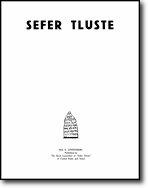 |
|
In 1961, more than 50 former residents
of Tluste participated in the publication of a memorial
volume to commemorate their experiences. Published by
the Tluste Organization in Israel and the "Landsmannschaft"
in the United States, "Sefer Tluste" (18)
contains a unique collection of reminiscences of Jewish
life and death in Tluste. The complete volume can be
accessed online through the
New York Public Library website.
|
The introduction to "Sefer Tluste" explains:
"Tluste was the last city in Eastern Galicia to undergo
the process of total extermination, so it contained those
Jews who had survived earlier "Aktions" in the
neighbouring towns. Out of the three thousand Jewish residents
of Tluste and the thousands of refugees from the neighbouring
towns, less than five hundred survived at the end of the
Second World War.
Immediately following their arrival the Germans commenced
their cruel and merciless oppression of the Jewish inhabitants.
Decrees restricting Jewish freedom of movement and preventing
the Jews from continuing their normal lives were enacted
almost daily. They were followed by the murder of isolated
Jews, and finally came the massacre of thousands of Jewish
residents of Tluste and the vicinity."
The following description of what happened in Tluste between
1941 and 1943 is derived largely from the account of a Jewish
doctor, Baruch Milch,
who survived the systematic extermination of Jews from the
town. His compelling story is told through an edited diary
that came to be published as a book, Can Heaven be Void?
(19).
It was released in three different language versions
(Hebrew, Polish and English) between 1999 and 2003. Where
instructive, information to supplement that of Dr. Milch is
provided from other sources. 
The Beginning of the End
In June 1941, in the face of the German advance, the Soviets
pulled out of Tluste amidst incessant air raids. Pandemonium
and uncertainty reigned, as a Ukrainian mayor was installed
and a "settling of accounts" began. In Tluste and in other
villages and towns, rioting mobs of vengeful Ukrainians looted
houses and murdered Jews. After some time, soldiers of the
Hungarian army, allied with the Germans, arrived in town and
continued the plunder (20).
Towards the end of June and beginning of July 1941, a German
air and ground offensive hastened the Soviet retreat from
Zalishchyky, 25 km south of Tluste. The Russians destroyed
the railway bridge in the process in order to impede the German
advance (21),
but the town was captured anyway on 8 July 1941 (22).
The Germans eventually made their way to Tluste, passing through
the town from two directions (Czortkow and Borszczow), en
route to the north and east (23).
A small German force, including SS men, was installed in Tluste
to engage the retreating Soviets. It is thought that the explosion,
around that time, of a train full of arms at Tluste station
was an act of sabotage by the retreating Soviet forces (24).
In July-August 1941, a German officer became military governor
of Tluste; and the organised and systematic persecution of
Jews by the Nazis began in concert with a local Ukrainian
committee appointed by the occupying force (25).
It is written, more generally, that some Ukrainians expected
to be rewarded for their collaboration, with an independent
Ukraine. However, their hopes for statehood were dashed within
a couple of months when the Germans made it clear that there
would be no independent Ukraine. Rather, Galicia would be
an integral part of the German-occupied sector of Poland,
the Generalgouvernement (26).
| A nightly curfew was imposed in Tluste and
freedom of movement of Jews was curtailed. Around August
1941, the Germans set up a Judenrat (Jewish council)
under chairmanship of a Dr. Aberman, together with a Jewish
police force, in order to impose order, persecute the
Jewish community and facilitate mass deportations. |
|
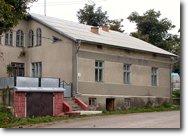 |
The Judenrat, housed in the building pictured above,
was guarded at night by Jewish policemen bearing the Star
of David on their uniform. Anti-Jewish edits were issued (imposing
forced labour, wearing of the Star of David, restricting movement
etc.) and periodic joint Gestapo-Ukrainian police raids begin,
characterised by searches of houses, beatings, arrests, murders,
and confiscation of property (27).
Similar scenes of persecution perpetrated by German soldiers
and Ukrainian collaborators were repeated in nearby towns.
In July, the killing of Jews and looting of homes began in
Czortkow, less than 20 km north of Tluste (28).
A Gestapo headquarters was established there, from where control
over Tluste would be exerted throughout the Nazi occupation.
From time to time, the Gestapo would travel to Tluste in a
black vehicle that came to presage arrests, extortion and
murder (29).
In Horodenka, about 20 km to the southwest, a reign of terror
followed the German occupation in July 1941, beginning with
anti-Semitic proclamations and deportations of Jews. A ghetto
was established there around October 1941 (30).
By September, the whole of Zalishchyky region had been occupied
and was administered by the Hungarian allies of the Germans.
In November-December 1941, there was a mass slaughter of Jews
near Zalishchyky (31)
and another of Horodenka Jews at Siemakowce (32).
Beginning around March 1942, a ghetto was established in
Tluste to which the remnants of Jewish communities from neighbouring
towns and villages were brought, prior to systematic deportations.
The Holocaust Chronicle website documents these expulsions
with photographs from the United States Holocaust Memorial
Museum Photo Archive:
Photo 1 and Photo
2. At some point, there was a forced influx of stateless
Jews expelled from Hungary and elsewhere. Arriving over a
two-week period on columns of trucks under the guard of Hungarian
soldiers, the refugees were robbed of their possessions and
many were killed when in the process of trying to return home
(33).
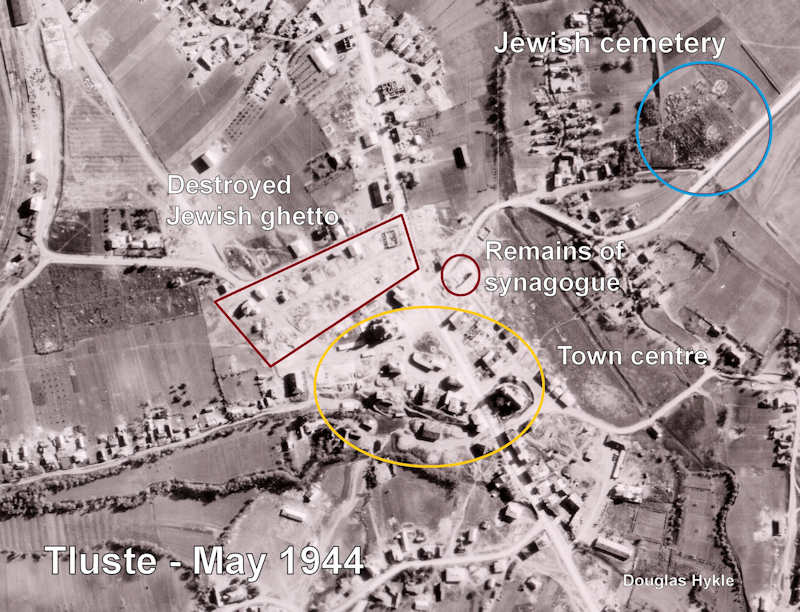 |
|
As shown here, in an aerial photograph of
the town centre, taken by German reconnaissance aircraft
in May-June 1944, the ghetto created after the 27 May
1943 Aktion was located on two streets adjacent to (northwest
of) the Greek Catholic Church.
Click on photograph to enlarge. |
Judenrat policemen collected money to buy food for
the ghetto prisoners -- cheese, bread, milk, meat, onions,
and even vodka (34).
People were crowded into small houses assigned by the
Judenrat, sometimes with as many as four or five families
living in a single room.The sanitary conditions were appalling,
and food was scarce (35).
Stars were placed on the doors of houses where the Jews lived;
this way the entire Jewish population was controlled.
At some point during this period, the mostly Jewish-owned
shops in the centre of Tluste were torn down and the wood
used for scrap. In the photo above, just to the north of the
Greek-Catholic cathedral, one sees only faint remnants of
the foundations where buildings once stood. Further to the
east, the stone edifice that had been used as a synagogue
for at least a half century (and previously as a fort, for
even longer) was also demolished. Only the rear wall remains
visible.
In Spring-Summer 1942, Jews were sent to labour camps in
vicinity of Tluste, such as the one at Lisowce (Lisivtsi).
Many were engaged there in the manufacture of synthetic rubber
from the plant called kok-saghys (36).
The first major, overt Aktion in Tluste took place
in August 1942, apparently intended to make up the shortfall
in a neighbouring town's "quota" of Jews to be deported (37).
On 27 August, the Germans ordered the Judenrat to
round up 300 people, who were then dispatched to Belzec (38)
by train. Smaller Aktionen followed repeatedly in
the coming months, in which armed Gestapo men would surround
the Jewish quarter and, helped by the Judenrat, rouse
people from their homes. Those who were not shot on the spot
for resisting or trying to flee were then assembled and crammed
onto trains, which carried them to their fate (39).
Baruch Milch reports that in between these periodic Aktionen,
Judenrat officials took advantage of the climate
of fear among the Jewish population to carry out acts of extortion.
"People changed beyond recognition and were ready to do anything
to survive, often at the expense of others, including relatives.
The real culprits, however, were those who had brought us
to this pass" (40).
People attempted to prepare hiding places in which to conceal
themselves during the successive Gestapo raids. See, for example,
'The Spitzer Story'.
On 20 September 1942, the Germans expelled Zalishchyky's
Jews to neighbouring ghettos; and most were sent to Tluste
(41). Similarly, in Horodenka, a 3-day Aktion
ended with the town being declared Judenfrei (free
of Jews) and any survivors were ordered to leave within 24
hours (42).
The following month, on 5 October, there was a second major
Aktion in Tluste and nearby villages. According to
Baruch Milch, who had been forewarned about the impending
raid, 1000 Jews were deported from Tluste and 120-200 or more
were killed in town (43).
It was said that the horrific scene of death and looting resembled
the aftermath of a pogrom.
During the winter of 1942-43, periodic expulsions from surrounding
towns continued, and Jews were increasingly concentrated in
ghettos. Amidst conditions of congestion and starvation, typhus
epidemics broke out in the ghetto of Tluste and elsewhere,
claiming 6-8 lives daily (44).
In an excerpt from her poignant memoir, "A Horodenka Holocaust
Memoir", Tosia Szechter Schneider recalls her experiences
in the Tluste ghetto:
"My mother, my brother, and I found ourselves in the ghetto
of Tluste. The winter of 1942 took a terrible toll from
starvation and typhus. That winter my mother made a last
attempt to save me. She met a Ukrainian man who said that
he would be willing to get for me false papers and to take
me to a far-away village to his cousin. My mother was overjoyed,
we knew we were all doomed. She spent two days teaching
me the catechism and how to behave in church. Every time
my resolve weakened but she kept repeating "someone must
survive to tell the world". Our greatest fear was that we
will all be killed and no one will know of the evil deeds.
I said good-bye to my brother and walked with my mother
to the end of the ghetto, I was to take off my armband and
steal across the gate. I was only 14 then but I thought
that all our people will be destroyed, and why would I want
to live in a world without Jews, and be part of a people
who, if not active participants in the murder of my people,
certainly stood idly by. I decided that it was not worth
it, to my mother's great dismay, and decided not to leave.
She did not urge me, she knew how uncertain that attempt
was, and we walked back to the ghetto.
I have never regretted that decision; in spite of the hunger
and suffering, I had a few more short weeks with her. My
mother contracted typhus and, at the age of 39, died of
starvation and disease.
We were left four children all alone; the oldest was my
cousin Bella, 17. I also became very sick with typhus and
I don't remember much of that winter. My brother credited
my survival to the "miracle" of the eggs: a Polish man who
lived close to the ghetto and who at one time worked with
my father, found out about us, and brought us eggs, practically
the only food we had, plus the meagre ration. But more than
sustenance, he brought some light of human kindness into
that world of darkness and despair."
Raids and killings continued through the winter, albeit on
a smaller scale, it would appear. O'Neil (45)
reports that on 12 February 1943, 40 Jews were shot in Tluste.
After a period of relative calm around the time of Passover,
in April 1943, news came of an Aktion in a nearby
town, heightening fears that Tluste would be next. Baruch
Milch suggests that there was to have been an Aktion
in Tluste then, but the Gestapo came and went after discovering
that nearly all of the Jews had dispersed throughout the area,
in anticipation of trouble (46).
The short reprieve, if one can call it that, continued for
a while, at least for some Jews who were able to secure documentation
permitting them to work as labourers in nearby camps. According
to Baruch Milch:
"The central nervous system of the area was our town, Tluste,
where one of the region's five Jewish communities lived.
Since ours was not a true ghetto, Jews enjoyed greater freedom
of movement in Tluste than elsewhere. Therefore, only some
1,800 of 5,000 Jews in the community were registered with
the authorities. The surrounding farms needed and found
many working hands, and a camp known as "W" (for Wehrmacht)
was built two kilometers from town for the families of "privileged"
Jews, particularly those close to the Judenrat.
... The Judenrat stepped up the transfer of able-bodied
Jews to the camps and invoked all kinds of ruses to save
their cronies." (47) 
The End
Amidst rumours of bloody Aktionen in nearby towns,
the third major Aktion in Tluste began in the early
hours of the morning of 27 May 1943. This horrific event would
effectively bring to an end the centuries-long presence of
Jews in Tluste. The Germans, supported by Ukrainian and Jewish
police, deployed around 1:00 or 2:00 a.m. For the next 20
hours, a contingent of about 300 men went from house to house,
rounding up Jews and slaughtering those who resisted. Ironically,
some who hid in improvised hideouts survived, whereas those
in more elaborate bunkers were discovered.
People were led to the town square where they were forced
to hand over their valuables. Able-bodied men were taken to
the Jewish cemetery to dig pits that would ultimately serve
as mass graves for the victims. Later in the afternoon, beginning
around 4:00 p.m., the captives were led in groups of 100 to
the cemetery. It is said that a Jewish musician in town, by
the name of Stupp, led the slow processions to the cemetery
while playing solemn music on his violin (48).
In a 2004 interview, an elderly resident of Tovste, who would
have been in her mid-teens at the time, described the massacre
as others — who had witnessed it first-hand —
had recounted it to her. She said that the Jews were ordered
to stand on planks of wood above the pits, into which they
fell after being shot. Not all of them died instantaneously.
It was said that the earth in which they were buried was seen
to move, as though some poor souls had been buried alive.
The woman recalled the villagers being perplexed as to why
the Jews did not attempt to escape from the ghetto, as would
have been possible, at least for some. She claimed that, in
response, one old man said that they were resigned to their
fate, being of God's will, and that "our blood will be on
you and on your children".
When the shooting finally ended around 9:00 in the evening,
it is estimated that from 2,000 to 3,000 Jews had been murdered.
A Gestapo officer was reported to have directed the whole
operation, and personally took part in the shootings at the
cemetery (49).
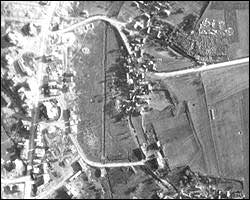 |
|
An aerial photograph of the cemetery
on the outskirts of town, taken by German reconnaissance
aircraft a year later, in June 1944, confirms this atrocity.
The Jewish cemetery is situated in the upper right
hand corner of this photograph. In the enlargement (viewed
by clicking on the image), one observes row upon row
of densely packed tombstones.
|
Amidst an area containing 25 or so rows of tombstones, there
is a large circular clearing towards the road where one can
make out the outline of two rectangular shapes. Further in
from the road, to the northeast, there is another circular
clearing surrounding what appears to be single, large rectangular
shape. It is believed that they contain the remains of the
victims of the 27 May 1943 massacre.
For Tluste, the last act of the 'Final Solution' played out
around 6 June 1943. That morning, Gestapo men and Ukrainian
surrounded the ghetto, and proceeded to shoot or bludgeon
to death many of the Jews who had survived the Aktion
ten days earlier. By this point, their hiding places were
insufficient, having been detected during previous raids.
The following day, the order came to purge Tluste of Jews
and declare the town Judenrein within two days (50).
It is reported that 1,000 Jews were killed or deported from
Tluste at that time (51).
The Sefer Tluste (52)
picks up the threads of the story:
"About two months later [i.e. by around August 1943] in the
town was declared "Judenrein" (cleared of Jews) and
no Jew had the right to be there. The handful who had escaped
death hid in forests or labour camps in the surrounding villages.
However, the residents of the camps were also liable to sudden
attacks by the Gestapo or the Ukrainian police, who collaborated
with the German murderers helping them to exterminate the
Jewish population."
Baruch Milch emerged from hiding in Czerwonogrod and returned
to Tluste some eight months later, at the end of March 1944.
Though the town was almost unrecognisable, he discovered that
some 200 or so Jews had actually survived in the labour camps
or from other hiding places (53).
"Many of the Jews who had fled to the forests fell into the
hands of the fanatic Ukrainian Bandera gangs, but some of
them joined partisan units. The remnants of the community
were liberated from the camps in the area in March 1944" (54).
Soviet forces regained at least partial control over the
region in the latter part of March and first half of April
1944. The Germans pulled out of Tluste during this time, but
a large contingent of soldiers, part of a force retreating
to the west, reoccupied the town for about a week before finally
heading towards Buczacz. The Soviets regained effective control
of Tluste on 13 April 1944 (55).
Jewish life was never reconstituted in
Tluste after the war. A memorial to these tragic events
can be found in what remains of the town's Jewish cemetery.
The Hebrew inscription, translated into English (56),
reads:
"In memory of the martyrs of Tluste and surroundings
who were annihilated by the Nazis in the years 1942-1943
and to remember all the martyrs who are buried in this
cemetery. Erected by the survivors from Tluste." |
|
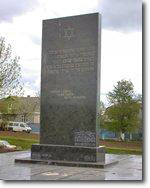 |
* * * * *
Much more could be written about the contribution of Tluste's
Jewish population to the life of the town. The Sefer Tluste
memorial book is an extremely rich source of information.
The original texts (in Hebrew and Yiddish) have now been completely
translated into English, and are available for viewing on
the website of JewishGen. Click here
for more details of this long-lasting effort.
Over the past decade, I have reviewed hundreds of written
and oral testimonials from Shoah survivors associated with
Tluste -- sourced from archives and other research institutions
in the United States, Israel, Poland, Germany, and Austria
-- and I have interviewed dozens of survivors from the town.
Eventually, the material from this exhaustive research will
find its way into a substantial publication. 
Notes:
(1) Rosman, M.J. Founder of Hasidism: a quest for the
historical Ba'al Shem Tov. Berkeley, 1996. p. 44.
(2) Ibid. p. 44.
(3) Ibid. p. 44.
(4) Stampfer, S. "What actually happened to the Jews of
Ukraine in 1648?" in Jewish History. 17: 207-227
(2003). p. 207.
(5) Rosman, M.J. Founder of Hasidism: a quest for the
historical Ba'al Shem Tov. Berkeley, 1996. p. 52.
(6) Ibid. p. 56-62.
(7) Ben-Amos, D. and J.R. Mintz (eds). In praise of
the Baal Shem Tov (Shivhei ha-Besht). Northvale, N.J.,
1993.
(8) Stampfer, S. "The 1764 Census of Polish Jewry" in
Bar-Ilan / Annual of Bar Ilan University Vol. 24-25.
p. 135.
(9) Encyclopedia Judaica. Jerusalem, 1972. Last
accessed via the Museum of Tolerance Multimedia Learning Center,
https://motlc.learningcenter.wiesenthal.org/text/x32/xr3263.html
on 18 August 2005.
(10) Statistische Monatschrift. VII. Jahrgang. Wien
1881. p. 448-51.
(11) The 1891 Galician Business Directory (Kaufmannisches
Adressbuch fuer Industrie, Handel und Gewerbe, XIV. Galizien,
published by L. Bergmann & Comp., Wien IX, Universitutmetr.
6): https://www.jewishgen.org/databases/Poland/galicia1891.htm;
last accessed on 14 August 2005
(12) "Summary of History of the Suchostaw Region": https://www.shtetlinks.jewishgen.org/Suchostaw/suchhistorysummary.html;
last accessed on 16 August 2005.
(13) Pawlyk, J. History of Tovste. Chortkiv, 2000.
p. 48-50.
(14) Summary of History of the Suchostaw Region: https://www.shtetlinks.jewishgen.org/Suchostaw/suchhistorysummary.html;
last accessed on 16 August 2005.
(15) Encyclopedia Judaica. Jerusalem, 1972. Last
accessed via the Museum of Tolerance Multimedia Learning Center,
https://motlc.learningcenter.wiesenthal.org/text/x32/xr3263.html
on 18 August 2005.
(16) International Jewish Cemetery Project: https://www.jewishgen.org/cemetery/e-europe/ukra-t.html;
last accessed on 16 August 2005.
(17) Encyclopedia Judaica. Jerusalem, 1972. Last
accessed via the Museum of Tolerance Multimedia Learning Center,
https://motlc.learningcenter.wiesenthal.org/text/x32/xr3263.html
on 18 August 2005.
(18) Lindenberg, G. (ed.). Sefer Tluste. Tel Aviv,
1965.
(19) Milch-Avigal, S. (ed.). Can Heaven be Void?
Jerusalem, 2003.
(20) Ibid. p. 73-5.
(21) Lecker, M. "I Remember: Odyssey of a Jewish Teenager
in Eastern Europe". In Montreal Institute for Genocide and
Human Rights Studies. Volume 5. https://migs.concordia.ca/memoirs/lecker/lecker.html;
last accessed on 14 July 2005.
(22) Pinkas Hakehillot Polin: "Zalishchyky" - Encyclopedia
of Jewish Communities, Poland, Volume II (Ukraine), pages
195-199. https://www.jewishgen.org/yizkor/pinkas_poland/pol2_00195.html;
last accessed on 18 August 2005.
(23) Milch-Avigal, S. (ed.). Can Heaven be Void?
Jerusalem, 2003. p. 75
(24) Pawlyk, J. pers. comm.
(25) Milch-Avigal, S. (ed.). Can Heaven be Void?
Jerusalem, 2003. p. 75.
(26) Ibid. p. 82.
(27) Lecker, M. "I Remember: Odyssey of a Jewish Teenager
in Eastern Europe". In Memoirs of Holocaust Survivors in Canada.
Volume 5. https://migs.concordia.ca/memoirs/lecker/lecker.html;
last accessed on 14 July 2005.
(28) Milch-Avigal, S. (ed.). Can Heaven be Void?
Jerusalem, 2003. p. 88.
(29) Szechter Schneider, T. "A Horodenka Holocaust Memoir".
https://www.shtetlinks.jewishgen.org/Gorodenka/html/holocaust_memoir.html;
last accessed on 9 February 2010.
(30) Pinkas Hakehillot Polin: "Zalishchyky" - Encyclopedia
of Jewish Communities, Poland, Volume II (Ukraine), pages
195-199. https://www.jewishgen.org/yizkor/pinkas_poland/pol2_00195.html;
last accessed on 18 August 2005.
(31) Schneider, T. "Visiting Horodenka, Fifty-three Years
Later". https://www.geocities.com/mrheckman/gorodenka/tschneider.html;
last accessed on 18 August 2005.
(32) Milch-Avigal, S. (ed.). Can Heaven be Void?
Jerusalem, 2003. p. 77, 88.
(33) Ibid. p. 79-80.
(34) Pawlyk, J. History of Tovste. Chortkiv, 2000.
p. 50.
(35) Schneider, T. pers. comm.
(36) Milch-Avigal, S. (ed.). Can Heaven be Void?
Jerusalem, 2003. p. 89.
(37) Ibid. p. 97.
(38) See also https://www.deathcamps.org/belzec/galiciatransportlist.html
(39) Ibid. p. 98-100.
(40) Ibid. p. 110.
(41) Pinkas Hakehillot Polin: "Zalishchyky" - Encyclopedia
of Jewish Communities, Poland, Volume II (Ukraine), pages
195-199. https://www.jewishgen.org/yizkor/pinkas_poland/pol2_00195.html;
last accessed on 18 August 2005.
(42) Szechter Schneider, T. "A Horodenka Holocaust Memoir".
https://www.shtetlinks.jewishgen.org/Gorodenka/html/holocaust_memoir.html;
last accessed on 9 February 2010.
(43) Milch-Avigal, S. (ed.). Can Heaven be Void?
Jerusalem, 2003. p. 102-3. (See also https://www.deathcamps.org/belzec/galiciatransportlist.html).
(44) Ibid. p. 105-6.
(45) O'Neil, R. Unpublished Manuscript and Introduction:
"A Reassessment: Resettlement Transports to Belzec, March-December
1942". https://www.jewishgen.org/Yizkor/belzec/belzec.html;
last accessed 18 August 2005.
(46) Milch-Avigal, S. (ed.). Can Heaven be Void?
Jerusalem, 2003. p. 112-13.
(47) Ibid. p. 114.
(48) Pawlyk, J. pers. comm.
(49) Milch-Avigal, S. (ed.). Can Heaven be Void?
Jerusalem, 2003. p. 121-131.
(50) Ibid. p. 138-41.
(51) O'Neil, R. Unpublished Manuscript and Introduction:
"A Reassessment: Resettlement Transports to Belzec, March-December
1942". https://www.jewishgen.org/Yizkor/belzec/belzec.html;
last accessed 18 August 2005.
(52) Lindenberg, G. (ed.). Sefer Tluste. Tel Aviv,
1965.
(53) Milch-Avigal, S. (ed.). Can Heaven be Void?
Jerusalem, 2003. p. 228.
(54) Encyclopedia Judaica. Jerusalem, 1972. Last
accessed via the Museum of Tolerance Multimedia Learning Center,
https://motlc.learningcenter.wiesenthal.org/text/x32/xr3263.html
on 18 August 2005.
(55) Milch-Avigal, S. (ed.). Can Heaven be Void?
Jerusalem, 2003. p. 231.
(56) Schneider, T. "Visiting Horodenka, Fifty-three Years
Later". https://www.geocities.com/mrheckman/gorodenka/tschneider.html;
last accessed on 18 August 2005.

|

